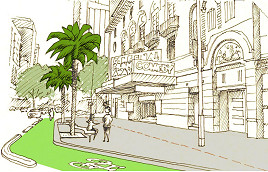Hoddle Grid Heritage Review
A comprehensive review of unprotected heritage buildings across the CBD, the Hoddle Grid Heritage Review has finally been adopted into the planning scheme by the City of Melbourne.
It follows many years of work by council officers, councillors, submitters and heritage consultants, as well as many more years of advocacy from Melbourne Heritage Action and others.
This amendment finally protects so many heritage buildings that many readers would have assumed were already protected, as well as a few pleasant surprises from the post-war era.
Here are a few of our favourites from the list so stare up at next time you’re in the city …
Greater Western Hotel
Many Melburnians would assume a bluestone pub built in 1864 would have some sort of heritage protection, but this wasn’t the case until 2022, when the Hoddle Grid Heritage review went through its final stages of approval.
Although the pub stopped trading in 2017, this heritage review has at least been enough to save the building as part of a future development where it will once again be used as a corner pub, having been saved from complete demolition by new heritage listing and negotiations between council and developers.
Melbourne House – 354-360 Little Bourke St
Melbourne House was controversially left out of previous heritage studies, and then condemned to demolition for a hotel development, causing controversy from nearby residents. But now, because of this heritage review process, the building will be retained and restored with an appropriately setback addition behind. It doesn’t currently look it’s best behind ground floor hoardings and blue paint, but just wait a year or two.
Flinders Lane between Spring and Russell streets
It may surprise readers that barely any of the former rag trade buildings surrounding some of our most iconic street art precincts along Flinders Lane were unprotected, but this has been the case until now.
13 Collins St
This heritage study has for the first time comprehensively reviewed many places built after World War Two, including this brown brick gem built in 1970 to a design originally by Roy Grounds, most famous for the NGV, and finished by Karl Popper, an Austrian Jewish refugee who barely escaped from Europe before the war and went on to make a career of residential projects across Melbourne.
You may have looked up at this austere building many times from the tram stop without realising its importance in changing Australian minds to the idea of CBD apartment living.
These just a handful of the hundreds of buildings looked at in the Hoddle Grid review, and the full documents are well worth a look. But with their passing, you can now be fairly certain that just about any building you think should be protected in the CBD, now is •

Council endorses office tower at Flinders Lane despite querying car park demolition



 Download the Latest Edition
Download the Latest Edition